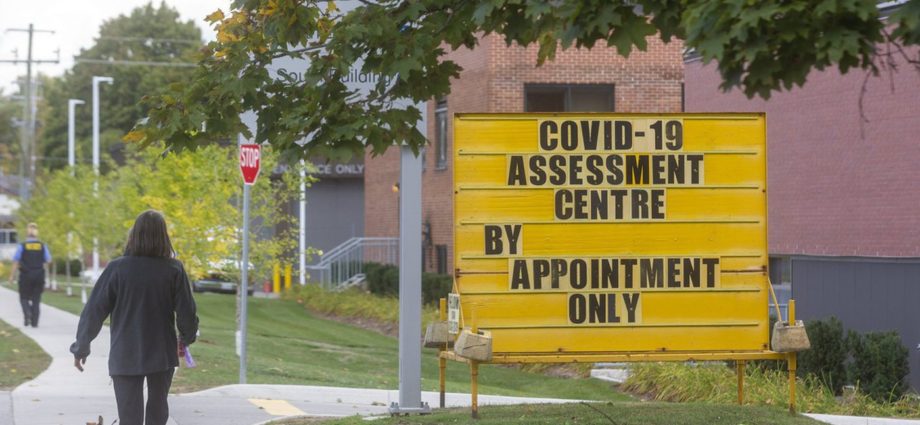COVID-19 surging in rural communities across region
The COVID-19 assessment centre at St. Thomas Elgin General Hospital operates seven days a week by appointment only. Mike Hensen/The London Free Press.
By Max Martin, Local Journalism Initiative Reporter, London Free Press
January 1, 2021
Rural regions in Southwestern Ontario continue to grapple with surging coronavirus caseloads as the health unit for Oxford and Elgin counties recorded its highest single-day COVID-19 case count Thursday with 71 new infections.
The new single-day high smashes Southwestern Public Health’s previous record of 47 cases on Dec. 23 and comes as Ontario also hit an all-time high with more than 3,300 cases provincewide.
“It’s not because it’s coming in from the outside, it’s now in our communities,” said Joyce Lock, the area’s top doctor. “We’re seeing cases in families, in workplaces, in schools and we’re seeing cases in social events where people get together. It’s coming from all different sectors at the moment.”
New modelling from the health unit projects the region will begin to see 100 daily cases or more in early January, which could be a tipping point in the pandemic.
The health unit’s percent positivity sits at 3.5 per cent, above the critical threshold of three per cent that is often used to determine if a region is at risk of being overwhelmed.

“Once we start to see daily increases approaching 100 per day, it becomes very difficult to conduct contact tracing within 24 hours to contain the virus,” Lock said. “Our team is working at maximum capacity, our local health care system is strained, and we are urgently asking for your support to modify behaviours to stop the spread.”
The health unit reports 19 people are being treated in area hospitals for COVID-19, with six in intensive care.
Southwestern Public Health has logged 1,286 infections since the pandemic began, with 295 active cases.
Tillsonburg has 67 active cases, more than any other municipality within the health unit’s jurisdiction. St. Thomas has 58 active cases, Aylmer 55, East Zorra-Tavistock 33 and Woodstock 31.
Thirteen people in the region have died of COVID-19.
Seven long-term care and retirement homes have active outbreaks across Oxford and Elgin counties. There are 65 ongoing resident cases and 51 staff cases, with the majority spread between Maple Manor long-term care home in Tillsonburg and PeopleCare Tavistock long-term care home.
Meanwhile, Chatham-Kent added 14 new cases on New Year’s Eve and hit an all-time high for active cases with 99.
The previous record was 93 on Aug. 7.
Active cases in the region have more than doubled since Dec. 23, with Chatham-Kent logging a two per cent positive rate last week.
Two long-term care homes in the region are in an outbreak. Three people in the area have died throughout the pandemic.
In Huron and Perth counties, 17 new cases were added Thursday. The number of active cases is 82, up from 53 on Christmas Eve. Active cases in the area peaked at 101 this past Monday.
Huron-Perth Public Health also logged its 22nd death Wednesday, a resident of Exeter Villa long-term care home in South Huron. The Exeter Villa outbreak has infected 14 residents and six staff.
Listowel Memorial Hospital remains in an outbreak, with 14 total cases between staff and patients.
In the region, three additional long-term care homes and two retirement homes have active outbreaks. Huron-Perth logged a positivity rate of 2.3 per cent the week of Dec. 20.
Across Lambton County, 23 new COVID-19 cases were added Thursday.
Lambton Public Health is reporting 157 active cases, with a 3.3 per cent positive rate recorded last week, also above the three per cent community spread threshold.
Since the pandemic began, 28 people in the Lambton region have died.
As health-care systems, resources and contract tracing capacities become strained amid rising case counts, Lock urges anyone who tests positive for COVID-19 to alert their close contacts and advise them to self-isolate.
She’s also encouraging everyone to download and use the COVID-19 Alert app, along with maintaining the basics of mask-wearing, hand washing, physical distancing and only leaving the home for essential reasons.
Although Ontario remains in a provincewide lockdown, Lock said 10 months into the pandemic, lack of adherence to public health guidelines is less from restriction fatigue and more because peoples’ fear of the virus has diminished.
“Initially, I think people were afraid,” she said. “Now we’ve come to know that although the virus can kill and can put people in the hospital and the ICU, that often, for many, it’s just a very mild cold infection. I think we’ve lost our fear.”
But Lock said the risk is still there.
Subscribe to our newsletter.
“All of us do need to continue to remember for every 10 of us that gets sick, one or two will end up in the hospital,” Lock said. “For every 100 that get sick, somebody will die and it’s our loved ones.”

